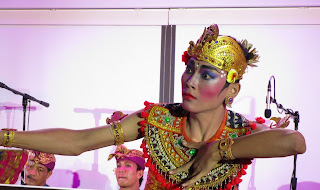Today was the one day when a majority of the passengers took the same optional tour. They went to the Great Barrier Reef. Since we had been there, we did not go. I went on an adventure to a crocodile farm. It is illegal to hunt for crocodiles in the wild as they are a "protected animal," but the demand for crocodile skins for handbags, belts and shoes still exists. Crocodile meat is also eaten.
I tried some and found it quite good. Now crocodiles are farmed just like cattle and pigs. The process is a bit different, however. When a female crocodile lays eggs, she builds a mound of dirt and leaves, lays 40 - 60 eggs and covers them with sand. She then crawls back into the water and patrols the area to make sure no predators eat the eggs. Here's the dangerous part. 3 employees go to the nest. two of them distract the female while the third digs up the eggs. As each egg is uncovered, it is marked to indicate which side is up. There is an air chamber in the egg which must remain on the top or the embryo will drown. The eggs are hatched at exactly 90 degrees so that they develop into males. A higher or lower temperature will produce females. Males are desirable because they grow faster and can therefore be "harvested" sooner. It's all about controlling costs.

![]()
Hatchlings are kept in dark tanks for a few months to speed development, then transferred to open tanks with a few hundred other males. If there are too few animals, they get territorial and fight to defend their turf. If there are too many, they fight for space. They fight anyway, but this has proven to minimize the number of fights. When they reach the desired length, about 3 - 4 feet, they are taken out and inspected. If there are no battle scars, they are euthanized and the skin is sold. The meat could also be sold, but at this park they keep the meat to sell in the food booth. If there are minor scars, the lucky croc goes back to the tank until the next culling so the wounds have time to heal. If the scar is too bad, the hide is worthless, so they either put them in the enclosed lagoon or just sell the animal for pet food. It is all very businesslike with the crocs getting humane treatment.

These are saltwater crocodiles, but they can live in salt or fresh water. They have a way to excrete excess salt when they are in salt water. These are also the famous jumping crocodiles which can grow to over 18 feet long and weigh close to a ton. If they are in the water and sense prey close to the water, they use their powerful tail to propel themselves into the air to catch the food. They do not come completely out, just the front 3 to 4 feet. When the jaws snap shut you can hear a loud snap. The guide dangled chicken parts off a string on the end of a long pole so we could see how fast and how high they jump. You do not want to go swimming with these fellows!
The park is also home to many other Australian animals, birds and reptiles. The cassowary is the most dangerous bird to humans. It stands about 4 feet high, is shaped like an ostrich, and can kick with its sharp toe nail claws hard enough to tear open a person. They do not like people or even other cassowaries, so each of the four at this park has a separate enclosure.



The saying in Australia is that nature is out to kill you. Between kicking birds, jumping crocodiles and venomous snakes, you better watch out where you walk. One of the few animals that just wants to be left alone is the koala. These cute little animals eat only one species of eucalyptus leaf which provides little nutrition, so they sleep over 20 hours a day. The babies are small and immature when born and live for several months in the mothers pouch, nursing and developing. Even after they crawl out, they stick close to Mom or any other koalas to ride on their backs or cuddle up. I got to pet the koalas, and they feel just like petting a dog.

Kangaroos roam freely in one section of the park and food is available so you can fee them. These are not the big red kangaroos, but the smaller grey kangaroos who stand about 3 - 4 feet tall. They are so used to people that they let you come right up to them. If you hold out food on your hand, they will eat out of your hand. Although they have harp teeth, they do not bite. It was a lot like having a horse nibble food off your hand.

I also got to hold a baby crocodile and a black-headed python.
One exhibit had American alligators. Our guide felt that they were so much less dangerous than crocodiles, that he went into the pen with them to retrieve an alligator tooth that was on the ground. Crocodiles and alligators loose teeth regularly and a new tooth is ready and waiting to come in. At the same time, another tooth is forming to take the place of the new tooth when it eventually falls out.
Darrell took the included tour around the town of Cairns (pronounced cans). The waterfront park still exists in downtown Cairns, but the little restaurants facing it have been replaced with tall hotels. Cairns does have a very nice Botanical Garden.

















































